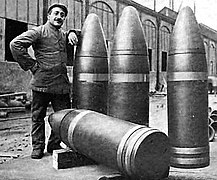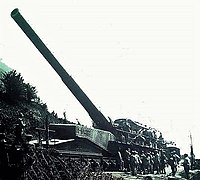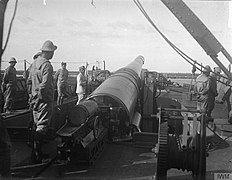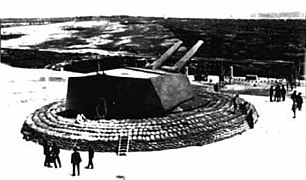Cannone navale da 381/40
Breech Interrupted screw | | |
| Elevation | +20°, later +30° | |
| Muzzle velocity | 700 m/s (2,297 ft/s) | |
| Effective firing range | 19,800 m (21,700 yd) at +20° elevation | |
| Filling weight | 38.5 or 50 kg (85 or 110 lb) | |
The Cannone navale da 381/40 was an Italian naval gun intended to equip the
Development
Italy planned a class of four
Ammunition
| Type of shell | Muzzle velocity[2] | Weight[2] | Range at +20°[3] | Range at +30°[3] |
|---|---|---|---|---|
High-explosive
|
700 m/s (2,297 ft/s) | 875 kg (1,929 lb) | 19,800 m (21,700 yd) | 27,300 m (29,900 yd) |
Armor-piercing
|
884 kg (1,949 lb) |
Service
The Francesco Caracciolo-class ships were
Coast-defense guns
One twin-gun turret was built as Batteria Amalfi on the Cavallino coast (northeast of Venice). Construction began in September 1915 and took 17 months to complete. Equipped with a pair of Vickers-Terni guns, the turret was installed on the roof of a concrete bunker that contained the ammunition, and the sleeping quarters for the artillerymen manning the turret. Electrical generators and the hydraulic pumps were in separate structures connected to the main bunker by tunnels. At their thickest point the bunker's walls were 9 meters (29 ft 6 in) deep and its roof was 3 meters (9 ft 10 in) thick. The frontal armor of the turret was 400 millimeters (15.7 in) thick, its sides were protected by 300-millimeter (11.8 in) armor and it had a roof 150 millimeters (5.9 in) thick. The guns in the turret had a maximum elevation of +20°. The turret could revolve 360°, which allowed it to provide fire support for the Italian forces within range during the Second Battle of the Piave River in June 1918.[5]
Two other twin-gun turrets were installed near Brindisi: Batteries Benedetto Brin and Fratelli Bandiera. Construction of both began in 1916, but only the former was completed during the war, test-firing its Armstrong-Pozzuoli guns in September 1917. The latter was originally planned to be equipped with 305-millimeter (12 in) guns, but it was modified to suit a pair of Armstrong-Pozzuoli guns in 1917; construction was suspended later that year,[3] before it was finally completed in 1923. These bunkers were almost identical to Amalfi, except that they were entirely self-contained.[6]
Although three other twin-gun turrets were planned during the 1930s, only one (Batteria Capo S. Panagia) north of Augusta, Sicily, was actually built, completed in 1934 with Armstrong-Pozzuoli guns. This turret was different than the earlier ones as its ammunition was loaded through doors in the rear of the turret, rather than the naval-type hoists previous used. Its gun could elevate to +30°. After the Italian declaration of war on France and Britain in June and the British bombardment of Genoa in early 1941, two turrets were built near the port: Batteria Monte Moro in Quinto al Mare-Genoa and Batteria Punta S. Martino in Arenzano-Genoa. Both were completed in mid-1942 and they were the same type as the turret installed in Sicily.[7]
After
Railroad guns
Seven of the Schneider-Ansaldo guns were transferred to the Army
Coastal monitors
Two Ansaldo guns were mounted on the monitor
The monitor
Gallery
-
A 381/40 on a test rig.
-
381 mm shells
-
A 381/40 AVS railroad gun
-
381/40 guns being installed on the monitor Alfredo Cappellini
-
Loading a 381/40 on a monitor during the Battle of the Piave River, June 1918
-
The Amalfi battery at Punta Sabbioni, Venice, 1920
-
The Amalfi battery
See also
- BL 15 inch Mk I naval gun: British naval equivalent
- 38 cm SK L/45 "Max": German naval and land equivalent
References
- ^ Clerici, Flocchini & Robbins, pp. 151–152
- ^ a b c Friedman, pp. 231–232
- ^ a b c d e f Clerici, Flocchini & Robbins, p. 154
- ^ Clerici, Flocchini & Robbins, p. 152
- ^ Clerici, Flocchini & Robbins, pp. 152, 154
- ^ Friedman, p. 231
- ^ Clerici, Flocchini & Robbins, pp. 154–156
- ^ Clerici, Flocchini & Robbins, pp. 156–157
- ^ Kosar, p. 234
- ^ Romanych & Heuer, p. 24
- ^ Zaloga, p. 27
- ^ Brescia, p. 181
- ^ Ordovini, Petronio; et al., p. 335
- ^ Trawick & Wilterding, p. 298
- ^ Ordovini, Petronio; et al., pp. 335–336
- ^ Ordovini, Petronio; et al., pp. 335–337
Sources
- Brescia, Maurizio (2013). Mussolini's Navy: A Reference Guide to the Regia Marina 1930–1945. Annapolis, Maryland: Naval Institute Press. ISBN 978-1-59114-544-8.
- Clerici, Carlo; Flocchini, Alfredo & Robbins, Charles B. (1999). "The 15" (381mm)/40 Guns of the Francesco Caracciolo Class Battleships". Warship International. 36 (2). International Naval Research Organization: 151–157. ISSN 0043-0374.
- ISBN 978-1-84832-100-7.
- Gardiner, Robert & Gray, Randal, eds. (1985). Conway's All the World's Fighting Ships 1906–1921. Annapolis: Naval Institute Press. ISBN 0-85177-245-5.
- Kosar, Franz (1999). Eisenbahngeschütz der Welt [Railroad Guns of the World] (in German). Stuttgart: Motorbuch. ISBN 3-613-01976-0.
- Ordovini, Aldo F.; Petronio, Fulvio; et al. (December 2017). "Capital Ships of the Royal Italian Navy, 1860–1918: Part 4: Dreadnought Battleships". Warship International. LIV (4): 307–343. ISSN 0043-0374.
- Romanych, Marc (2017). Railway Guns of World War I. London: Osprey Publishing. ISBN 978-1-4728-1641-2.
- Trawick, Henry P. & Wiltering, John H. Jr. (2010). "Italian Monitor Faa di Bruno". Warship International. XLVII (4). Toledo, Ohio: International Navy Research Organization: 297–298. ISSN 0043-0374.
- ISBN 978-1-4728-1068-7.
Further reading
- Anderson, Richard M.; Brescia, Maurizio & Del Prete, Maurizio (1989). "Question 53/87". Warship International. XXVI (2): 198–200. ISSN 0043-0374.







